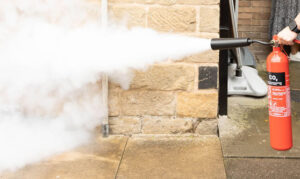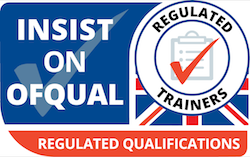Fire extinguishers are essential tools for combating small fires, but their use requires caution and awareness. When used correctly, they can stop a small fire from advancing to a dangerous and uncontrollable level, helping to prevent extensive damage and potential harm. While CO2 and powder extinguishers are effective in extinguishing flames, there are inherent risks associated with their use, especially in confined spaces.
Consider this discussion as a preliminary look at fire extinguishers to get you acquainted with some of the basics. However, please remember that this can not replace the invaluable knowledge you can acquire through appropriate training.
Fire Extinguisher types:
The contents and chemicals within fire extinguishers vary based on their intended use. Here are the typical extinguishing agents used in each class of fire extinguishers:
Class A Fire Extinguishers:
For ordinary combustibles such as wood and paper.
Contents: Water or water-based solutions, which cool and smother the fire by reducing the temperature and displacing oxygen. Additional additives may be used to enhance the extinguishing properties, such as foam or wetting agents.
Class B Fire Extinguishers:
Geared towards flammable liquids such as gasoline and oil.
Contents: Dry chemical powders, foam, or carbon dioxide (CO2).
Dry chemical powders work by interrupting the chemical chain reaction in the fire, while foam and CO2 smother the fire by displacing oxygen.
Class C Fire Extinguishers:
Engineered for electrical equipment fires
Contents: Dry chemical powders or carbon dioxide (CO2).
Similar to Class B extinguishers, dry chemical powders interrupt the chemical reaction, and CO2 displaces oxygen to extinguish the fire.
Class D Fire Extinguishers:
Designed to combat combustible metal fires.
Contents: Dry powder specifically designed for the type of combustible metal involved in the fire.
Different types of dry powders are used for different metal fires, as using the wrong type can potentially exacerbate the fire.
Class K Fire Fire Extinguishers:
Exclusively for cooking oil and fat fires
Contents: Wet chemical agents; which not only cool the fire but also establish a foam barrier to prevent re-ignition.
Are These Chemicals Considered Safe?
Fire extinguishers contain a variety of dry powders, each composed of different chemicals. Some of these powders are also commonly used in the food industry, such as baking soda and similar substances. On the other hand, Class D extinguishers use specific powders tailored to the type of metal involved. These can range from simple substances like sodium chloride (table salt) to graphite-based powders and more specialised compounds.
The potential risk with these powder-based extinguishers arises when they are used in confined spaces. Upon discharge, the powder can reduce visibility and impede the user’s ability to breathe, potentially jeopardising their ability to safely exit the fire-affected area.
In the case of wet chemical agents found in Class K extinguishers, substances like potassium acetate and similar compounds are employed. These agents closely resemble vinegar and are recognised for their safety and environmental friendliness. It’s important to note that all of these extinguishers are safe to use, but their proper usage is crucial to ensuring safety.
The Risks of CO2 Fire Extinguishers in Confined Spaces
Carbon dioxide (CO2) extinguishers work by displacing oxygen, effectively suffocating the fire. However, when used in confined spaces, there is a heightened danger that the user may become overwhelmed by the sudden increase in carbon dioxide emissions. CO2 is an asphyxiant, and the limited space means oxygen is replaced much faster. This creates a potentially life-threatening situation for the user.
It’s important to note that using the wrong type of fire extinguisher on a specific fire can be dangerous and ineffective. Therefore, it’s crucial to have the appropriate fire extinguisher for the specific fire hazards in a given environment. Not only that, but the knowledge and training to operate them safely and effectively.
Always read the labels and follow the instructions on the fire extinguishers to ensure their proper use in case of a fire emergency. Additionally, regular maintenance and inspections of fire extinguishers are essential to ensure they are in proper working condition when needed.
Above all training should be provided to all individuals who may use a fire extinguisher so that they are confident and capable in an emergency.











